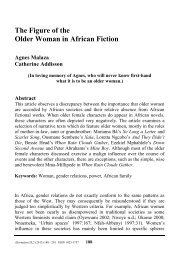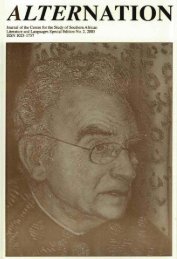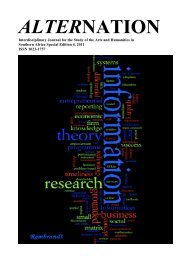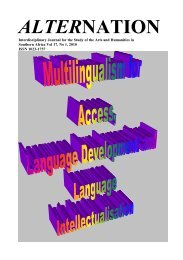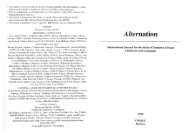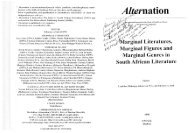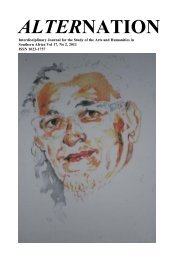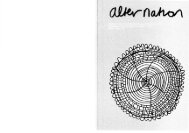Shane Moran - Alternation Journal
Shane Moran - Alternation Journal
Shane Moran - Alternation Journal
Create successful ePaper yourself
Turn your PDF publications into a flip-book with our unique Google optimized e-Paper software.
Ilklo Women Critics crnd ,S'ortth Afvican English I,iterarj) Studies<br />
state bureaucratisation and regimentation, which in the cultural sphere reproduced<br />
ile she recognises that the desire to preserve indigenous oral traditions can be an<br />
itself in the doctrine of socialist realism, and the rise of the proletkult movemen<br />
portant element of an insurgent nationalism, she is also wary of the ideological and<br />
Consequently, Literature and Revolution treads a difficult path between a<br />
itical consequences of such preoccupations in the hands of the less scrupulous. For<br />
endorsement of revolutionaly literature, and an indictment of emerging tendencie<br />
government official, their existence is used to justify oppressive racial policies like<br />
towards rigid ideological prescription and control in the cultural sphere. Much<br />
steeship' and 'separate development', and for the missionary-under the auspices<br />
'Trotsky's contribution lies in his attempt to take up the problem posed in Marx's k<br />
a mission-controlled press-they become a vehicle for religious indoctrination.<br />
argument in the 'Preface to A Contribution to the Critique ofPolitical Economy' (1 85<br />
ming to African writing of the early twentieth century, Taylor argues that the material<br />
that 'changes in the economic foundation lead sooiler or later to the transformation<br />
ions of racial oppression and economic exploitation, and a corresponding<br />
the whole immense superstructure' (Marx 1992:426). In his 'cultural continuity' th<br />
a1 docility, have been inimical to the growth of culture:<br />
'Trotsky reiected the notion popular amongst Soviet intellectuals in the 1920s that a<br />
proletarian culture would bk fonned in 'l&oratory' conditions under the direction o<br />
Culture requires a sound basis on wltich to build. Where is it for the<br />
proletarian avant-guard. Both Trotsky and Lenin had argued that continuities with African? There is no basis. There is an abyss. Africans form an oppressed<br />
Revolutionary bourgeois culture should be preserved and extended rather mass, without political power. without democratic rights; their political and<br />
discarded. What Taylor shares with Lenin and Trotsky is the attempt to apply Ma economic destitution is summed up in the pass laws, in the Colour Bar Act.<br />
categories to literature, and a desire to complement critical endeavour with a in the Urban Areas Act. in the Land Act, in the whole policy of segregation.<br />
participation in political struggle. Taylor's critical method is based on the assumptio Under sucli conditions there must be cultural destitution also (1 9421n: 10).<br />
that<br />
Aside from the ~overtv of its inaterial base, another factor that contributes to the<br />
the writer is largely the product of the society and the culture that nourishes<br />
him and that an understanding of that society acts like a searchlight upon his<br />
work(l943~:12).<br />
and it is towards the identification of the social roots of art, that mu<br />
produced. She argues that, the economic, political and social context o<br />
production in South Africa has had a distinct bearing on the kind of culture which<br />
emerged. As she puts it: 'A culture ... bear[s] the stamp of its material basis' (1943<br />
According to her, the compromised political and economic position of white E<br />
speaking South Africans in the 1940s, bolstered as it was by a numbcr of<br />
scierice srclai~itcti ant1 watpcd aid cannot read<br />
Anoilicr good exa~nplc of llo~v Taylor<br />
lived iri the present' (1942l:lO). I-Iere, Taylor's remarks echo Trotsky's<br />
revolutionary distaste for the cultural 'backwardness' of an agrarian existence.<br />
In this regard, see also her discussion of tile work of Peter Abrahams ( 1943a).



